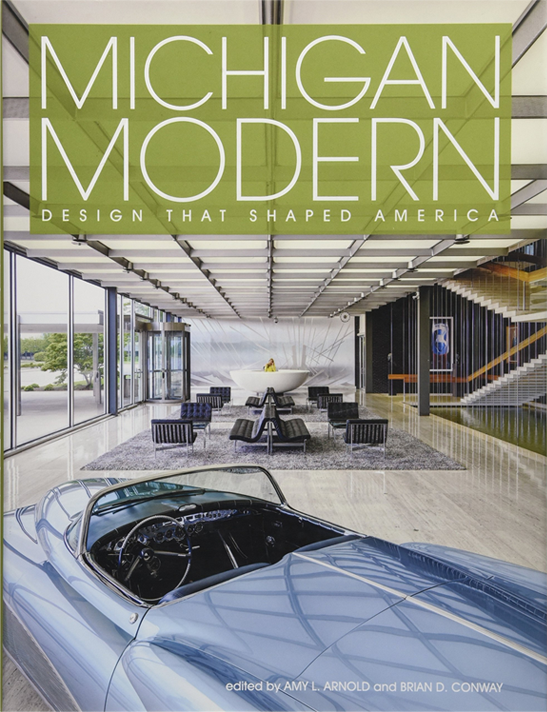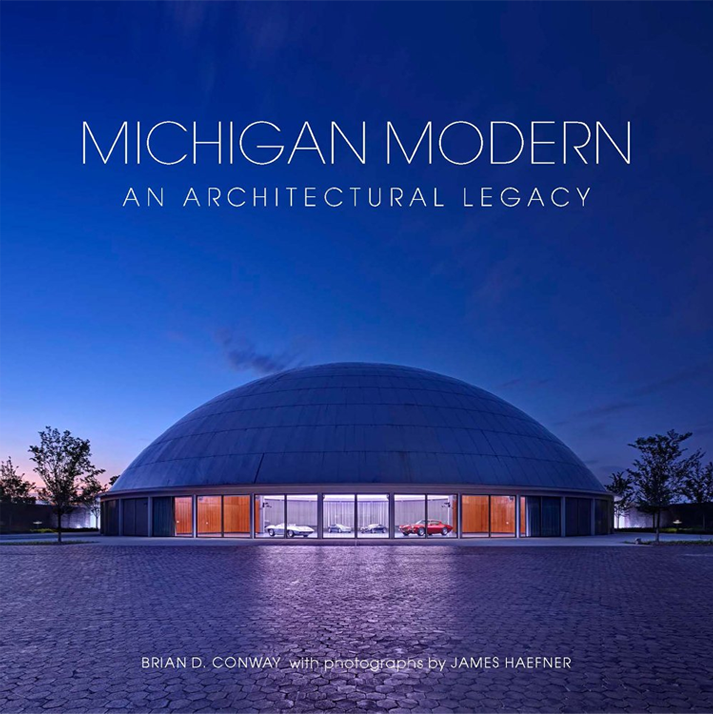Architects
Ralph Calder & Associates
A graduate of the University of Michigan, Calder founded Ralph Calder & Associates in 1945. The Detroit-based firm became a leading designer of university buildings and campus complexes in Michigan, including the Kanley Chapel (1953) at Western Michigan University, James Fisher Jr. Hall (1964) at Michigan Technological University and Abrams Planetarium (1964) at Michigan State University.
Alden B. Dow Associates
The son of the founder of the Dow Chemical Company, Alden Dow apprenticed with Frank Lloyd Wright at Taliesin. He opened his Midland, Michigan, practice in 1934. His home and studio, designed in 1936 with his patented Unit Block system, is a National Historic Landmark. Dow designed over 80 buildings in Midland ranging from residences to public buildings. His work is found throughout the state and nation. Dow remains the only architect to have been named architect laureate of Michigan (1983).
Harley, Ellington & Day (1943–60)
Alvin Harley and Harold Ellington joined forces in 1933 during the Great Depression and found work designing for the Stroh Brewery Company. Clarence Day became a partner in 1943. One of the most prominent Modern architectural firms in Michigan, they designed the south wing addition to the Detroit Institute of Arts in 1966. The firm also designed the International style Department of State Building in Washington, D.C. (1957-60).
Albert Kahn Associates
Albert Kahn began his practice in 1895 and became the architect for automaker Henry Ford, designing dozens of factory buildings. The River Rouge Glass Plant (1922) in Detroit and the Warren Tank Arsenal (1940) are cited as inspiring Modernism. Kahn’s work influenced the architect Le Corbusier and was a foundation for the creation of the International style. After Kahn’s death in 1942 the firm continued designing some of the Detroit area’s outstanding Modern buildings.
Giacomo Manzù
At the request of Minoru Yamasaki, this Italian sculptor and painter created outdoor bronze sculpture for the McGregor Memorial Conference Center at Wayne State University in Detroit in 1958. He is best known for the Portal of Death located at St. Peter’s Basilica in Vatican City, Rome.
O’Dell, Hewlett & Luckenbach Associates
Detroit native Augustus O’Dell partnered with Wirt Rowland, the designer of Detroit’s Guardian Building, from 1932 to 1938. Owen Luckenbach once worked for Smith, Hinchman and Grylls. After joining Thomas Hewlett, this Birmingham, Michigan-based firm designed many Modern buildings in the Detroit area including Ford Auditorium (1956; demolished 2011), two Cranbrook gymnasiums (1959 and 1964), and the Pontiac Silverdome (1975).
Glen Paulsen & Associates
Paulsen graduated from the Royal Academy of Art in Sweden in 1948. A designer for Eero Saarinen & Associates from 1953 to 1957, Paulsen became a lecturer at the University of Michigan in 1958. He served as the president of the Cranbrook Academy of Art from 1966 to 1970. Among Paulsen’s best work is his own residence in Birmingham (1955), Our Shepherd Lutheran Church (1966) in Birmingham, and the Ford Life Sciences Building (1967) at the University of Detroit Mercy.
Suren Pilafian
An Armenian immigrant, Suren Pilafian studied architecture at Columbia University and New York University. He worked with the architect Cass Gilbert in New York in 1928 and the industrial designer Norman Bel Geddes in 1938. Pilafian designed the Tehran Stock Exchange (1935) in Iran before coming to Detroit in 1942 to develop Wayne State University’s master plan. He later became principal designer for Albert Kahn Associates.
Minoru Yamasaki & Associates
Minoru Yamasaki, a Japanese immigrant from Seattle, came to Detroit in 1945 to become chief of design for Smith, Hinchman & Grylls. He later co-founded Leinweber, Yamasaki & Hellmuth and designed the Lambert-St. Louis Municipal Air Terminal (1956) along with several Detroit buildings before founding his own practice in Troy in 1959. He is most well known for the World Trade Center (1971) in New York City. The Federal Reserve Bank of Chicago, Detroit Branch Annex (1949–51) designed by Yamasaki was Detroit’s first curtain wall building, leading the way for other Modern buildings.


Available at your local book store and online.
Michigan Modern in Print
“Great historical review of the much under- appreciated Detroit/ Midland area Architects and designers. Written by extremely knowledgeable writers.”
The Great Lakes State has always been known for its contributions to twentieth-century manufacturing, but it’s only beginning to receive wide attention for its contributions to Modern design and architecture.
